Kaienthóhsera — Akwesasne Garden Initiative
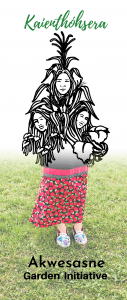
Under the Kaienthóhsera initiative, the Mohawk Council of Akwesasne is attempting to help with the food needs of Akwesasronon by providing raised garden beds to individual households. Each package will include an 8’x4’x1′ raised garden bed that will be delivered and installed at a location chosen by the residents. The soil will be provided as well as a tray of plants to be planted by the resident gardeners. Whether or not you have gardening experience, we will be providing assistance and information to help you be successful in growing food. The information being provided is grounded in who we are as Akwesasronon.
The Mohawk Council of Akwesasne would like to extend a big Niawen ko:wa to our local project funding and business partners – ACESS, Akwesasne Earth Movers, Northern – Landscapes and Two House Design-Crafters for making this project possible!



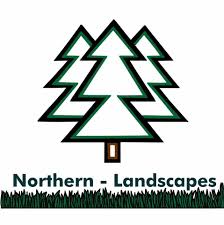

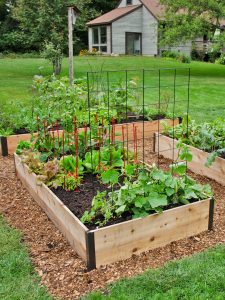
STEPS TO HELP YOU GROW YOUR GARDEN WELL
To help make your garden a success we have lots of information to help you. For best success, try to choose a location of your bed that is in direct sunlight (7 to 8 hours a day) and that is situated East to West. Clean the area of any debris. Save cardboard to put in the bottom of your bed. Now you are ready for the crew to install your bed and fill it with dirt. Because of current COVID-19 restrictions, please do not get too close to the crew.
When planting you can use our suggested layout (see diagram below). Relationships matter, so we created our layout with this in mind and where plants will not slow each other’s growth. Sectioning your garden into one foot sections will help make the planting process work better. Before putting your plants into your garden, make sure to pour a small amount of water into each of the holes that you prepare.
You will receive a tray of plants that include:
- Onions (3)
- Zucchini (1)
- Peppers (2)
- String Beans (3)
- Tomatoes: Cherry (1), Roma (2)
- Cucumbers (2)
- Pumpkin (1)
- Basil (2)
- Marigolds (1)
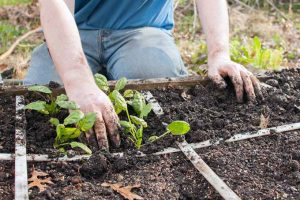
Water your garden as needed. Remember to water your garden earlier in the morning or closer to dusk. Water at the base of your plants as opposed to pouring water over the top. You also do not want to water at mid-day because the heat could burn your plants.
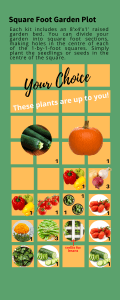
COMPANION PLANTING FOR YOUR GARDEN
Companion planting can improve your garden. See what vegetables to plant together for the best results!
Plants grow better with a little help from their friends, too! The practice of planting different varieties together is known as companion planting and can help ensure a healthy harvest of both crops. For example, taller plants can provide shade for ground-hugging plants, and some plants act as a pest repellant for their neighbours.
Other plants shouldn’t be planted together, either because they attract the same pests, or they stunt one another’s growth.
The benefits of companion planting stretch beyond the paired plants, too. Intercropping (or interplanting) flowers, vegetables, and herbs helps to prevent pests throughout your garden and improves biodiversity.
Rotating plants and mixing types of plants also keeps your soil healthy by not exhausting the nutrients in one area. See which plants are just waiting to be best friends and which ones should be best kept apart.
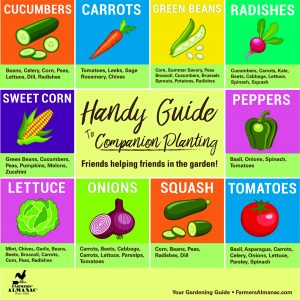
Corn + Squash + Beans (The 3 Sisters)
A classic trio, this plant combination has been used by the Haudenosaunee for hundreds of years, and for good reason: Tall corn stalks support climbing beans, and low-growing squash vines act as a ground cover that deters weeds. This combo of corn and vine crops works well with other plants, too. Try corn with cucumbers, melons, or pumpkins.
What to avoid planting with corn: Tomatoes
Tomatoes + Basil
Besides being tasty together in a salad, basil can help repel unwanted insects from your tomato plants. Planting them as a pair also works well because they require similar growing conditions. The best part? The two have the same harvesting time, which means you can use your freshly picked bounty together in recipes.
What to avoid planting with tomatoes: Cabbage family, corn, potatoes
Onions + Cabbage
Members of the cabbage family often fall victim to frustrating insects like the cabbage looper and cabbage worms. Onions can act as a deterrent to these bugs and also keep enterprising rabbits at bay. This pairing benefits the onion, too, as onion maggots spread more easily when the plants are close together. You can happily plant onions with cabbage, broccoli, kale, Brussels sprouts, spinach, and lettuce.
What to avoid planting with onions: Beans, peas, sage
Carrot + Leeks or Radishes
Carrots and leeks grow well together via a mutual pest control relationship. Carrots repel leek moths, and leeks repel carrot flies. Radishes are another option for carrot companions, as their seeds germinate earlier than carrots and ready the soil for carrots to sprout.
After you harvest radishes, the carrots will have plenty of room to thrive. Some herbs work well for planting with carrots—chives can improve flavour and encourage growth, while rosemary and sage also repel carrot flies.
What to avoid planting with carrots: Anise, dill, parsley
Flower Power: Marigolds or Nasturtiums
French marigold and nasturtium make excellent companion plants to a variety of vegetables, as they are natural insect repellants. They are thought to deter aphids, beetles, and more. Marigolds, in particular, discourage nematodes. These two flowers also attract beneficial pollinators. Take note, however; other varieties of marigold and hybrids will not have these properties. Plant a ring of French marigolds around your garden plot and enjoy their bright orange colour and protection!
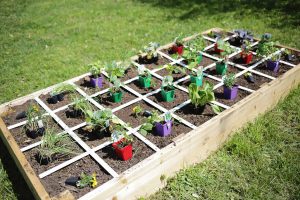
COMPOSTING
Compost makes the best soil. Organic rich garden soil that is bought from the store is expensive. When you invest a little time learning to compost, it’s all yours, for free!
It’s fun for kids to see how food decomposes. Kids love to sift through the finished and half-finished compost and see how kitchen scraps turn into black rich soil.
Composting reduces your household trash. Instead of brown lettuce leaves and egg shells sitting in the trash can for up to a week, these kitchen scraps can start decomposing right away in the compost pile.
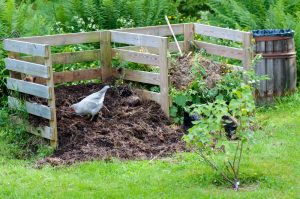
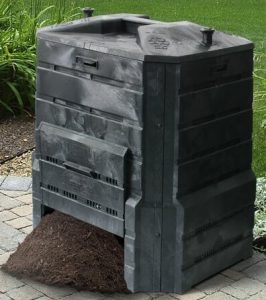
Composting is easy to do. You dump your compostables in and forget about them, until it’s time to harvest the rich, crumbly results of your (lack of) labour.
Composting is good for the environment. The best way to keep this material out of the landfill is to compost it at home.
Composting Basics 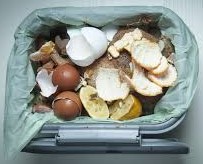
- Pick a spot for your indoor pail.
- Tell your family the plan. You might want to leave the pail out where it can be seen for a couple weeks to help everyone remember not to toss those apple cores and banana peels.
- Pick a spot for your outdoor pile or bin. You want it to be close enough to the house so that it’s not a big deal to carry the pail out every day.
What Can You Compost?
- Kitchen waste – Mainly produce trimmings. Think onion skins, celery roots, apple cores, banana peels, potato peels.
- Coffee grounds (filters are fine, too)
- Tea bags
- Grass clippings
- Dead leaves
- Straw
- Sawdust
- Garden waste
- Pet fur / floor sweepings
Don’t Compost These Things:
- Meat or bones
- Leftovers that aren’t primarily plant material
- Garden waste that has been treated with pesticides or chemical fertilizer
- Weed seeds and roots – you might inadvertently spread them to your garden beds
- Diseased plant material
Composting in Action
Now that you’re set up, just start collecting compostable material and add it to your pile.
Turn Your Compost Pile. Every month or so (or less often if you’re not in a hurry for finished compost), grab a pitchfork or a shovel and mix your pile up a bit. This helps speed up the decomposition process, heats up your pile, and keeps away any unwanted pests.
Harvest Your Finished Compost. Over time, the material at the bottom of your pile or bin will start to look like the nicest, richest soil you’ve ever seen. When you don’t see any more recognizable scraps, the compost is ready to be used. Harvest your compost from the bottom of your pile or bin once or twice a year.
Spread Your Finished Compost. Compost can be spread into your garden beds or used in container gardens.
Potential Problems
Smell. If your pile starts to smell at all, just give it a quick turn and add some grass clippings or leaves if available.
Not Enough Space. Composting only requires 9 square feet of space, or less if you choose a smaller space-saving bin (see photo above). And since it’s just about the easiest garden task you can undertake, composting is a good use of your yard space.
Animals. Depending on where you live, raccoons or rodents may be attracted to an open compost pile. If you work about that, you can either get the animal-resistant bin or turn your pile more regularly (a hot pile isn’t as attractive to animals).
HELP WITH YOUR GARDEN 
If you would like some guidance with maintaining or enhancing your raised garden bed, Kaienthóhsera can help you.
MCA Horticulture Ambassador Students will be available to assist you in helping to keep your garden growing healthy and happy. You can also get in touch with us in the way that suits you best: Facebook, e-mail, or by phone. See our contact information below.
To get your garden growing here are some great Facebook and Web links for you to look at:
- https://www.facebook.com/Ieienthos.Akotiohkwa/
- https://www.almanac.com/vegetable-gardening-for-beginners
- https://www.thespruce.com/how-to-make-raised-bed-garden-2539879
- https://www.gardeners.com/how-to/raised-bed-basics/8565.html
- https://savvygardening.com/preparing-a-raised-bed-garden
- https://www.almanac.com/sites/default/files/webform/pdf/almanac-start-a-garden.pdf
- https://www.almanac.com/sites/default/files/webform/pdf/2017-almanac-keep-garden-growing.pdf
Videos
Raised Bed Gardening
Composting
Worm Composting
CONTACT INFORMATION 
- Contact us by phone at (613) 936-1583 (ext. 1)
- Like our Kaienthóhsera – Akwesasne Garden Initiative Facebook page or
- E-mail: garden@akwesasne.ca

